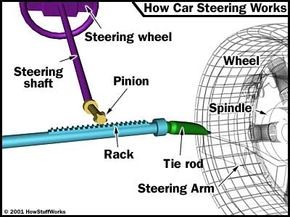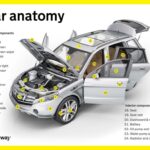Rack-and-pinion steering has become the dominant steering system in today’s vehicles, from compact cars to larger SUVs. Its popularity stems from its simplicity and efficiency in translating steering wheel input into directional control for the wheels. At its core, the rack and pinion car part mechanism is elegantly straightforward. It features a rack-and-pinion gearset encased within a metal housing. The rack, a linear gear, extends from both ends of this housing, and each end is connected to a crucial component known as a tie rod.
The pinion gear, a circular gear, is directly mounted to the steering shaft. When a driver turns the steering wheel, this rotational motion is transferred to the pinion gear, causing it to rotate. This rotation of the pinion gear then engages with the rack, compelling it to move linearly, either left or right depending on the direction of steering wheel input. Each end of the rack is linked to a tie rod, and these tie rods are, in turn, connected to the steering arm on each wheel spindle. This interconnected system ensures that the linear motion of the rack is effectively translated into the turning motion of the vehicle’s wheels.
The rack-and-pinion gearset performs two essential functions in the steering system:
- Motion Conversion: It expertly converts the rotational movement of the steering wheel into the linear motion required to steer the vehicle’s wheels effectively.
- Gear Reduction: It provides a mechanical advantage through gear reduction. This reduction makes it significantly easier for the driver to turn the wheels, as it multiplies the force applied to the steering wheel.
In most passenger vehicles, achieving a full range of wheel motion, from a complete left turn to a complete right turn (lock to lock), typically requires approximately three to four full rotations of the steering wheel. This balance ensures both responsiveness and manageable effort from the driver.
The steering ratio is a critical aspect of steering design, representing the relationship between the steering wheel’s rotation and the corresponding wheel turn. It’s calculated as the ratio of the steering wheel angle to the wheel angle. For example, a steering ratio of 18:1 indicates that for every 18 degrees of steering wheel rotation, the wheels turn by 1 degree. A higher steering ratio means more steering wheel input is needed for a given wheel turn, requiring less physical effort due to increased mechanical advantage. Conversely, a lower ratio results in quicker steering response, where less steering wheel movement translates to a larger wheel turn, often favored in sports cars for agility. While requiring slightly more effort, the enhanced responsiveness is a key characteristic of sporty handling.
Some vehicles incorporate variable-ratio steering systems. These systems utilize a specialized rack-and-pinion gearset with varying tooth pitch along its length. The tooth pitch, or the density of teeth, is finer in the center of the rack compared to the outer edges. This ingenious design achieves two key benefits: it provides highly responsive steering when initiating a turn, as the pinion engages the finer tooth pitch in the center of the rack, and it reduces steering effort when approaching the limits of wheel turn, where the pinion engages the coarser tooth pitch towards the rack’s edges.
Power Rack-and-Pinion Systems
In vehicles equipped with power steering, the rack-and-pinion mechanism is adapted to integrate power assistance. In a power rack-and-pinion system, the rack is designed with an internal cylinder and a piston assembly. This piston is directly connected to the rack itself and divides the cylinder into two chambers. Two fluid ports are incorporated into the cylinder housing, one on each side of the piston. The power steering system utilizes hydraulic pressure applied through these ports to assist steering. By directing higher-pressure fluid to one side of the piston, a force is generated that moves the piston and, consequently, the rack. This hydraulic force supplements the driver’s input, significantly reducing the effort required to turn the steering wheel, especially at low speeds or during parking maneuvers.
The subsequent components of the power steering system, responsible for generating and regulating the high-pressure fluid, along with the control mechanisms that determine which side of the rack receives pressure, are crucial for the overall functionality of power-assisted rack-and-pinion steering.

